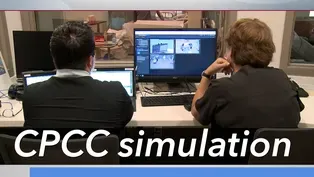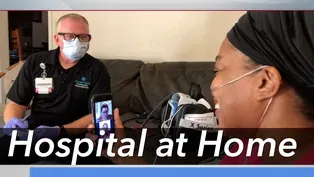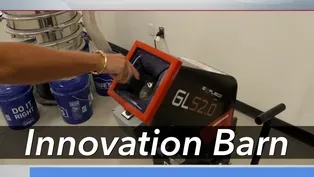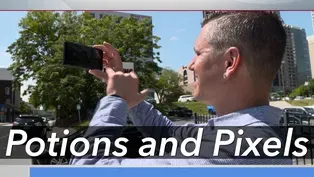
Carolina Impact: October 26, 2021
Season 9 Episode 7 | 26m 22sVideo has Closed Captions
Hospital at Home, CPCC Simulation, Potions and Pixels, Innovation Barn
Hospital at Home, CPCC Simulation, Potions and Pixels, Innovation Barn
Problems with Closed Captions? Closed Captioning Feedback
Problems with Closed Captions? Closed Captioning Feedback
Carolina Impact is a local public television program presented by PBS Charlotte

Carolina Impact: October 26, 2021
Season 9 Episode 7 | 26m 22sVideo has Closed Captions
Hospital at Home, CPCC Simulation, Potions and Pixels, Innovation Barn
Problems with Closed Captions? Closed Captioning Feedback
How to Watch Carolina Impact
Carolina Impact is available to stream on pbs.org and the free PBS App, available on iPhone, Apple TV, Android TV, Android smartphones, Amazon Fire TV, Amazon Fire Tablet, Roku, Samsung Smart TV, and Vizio.
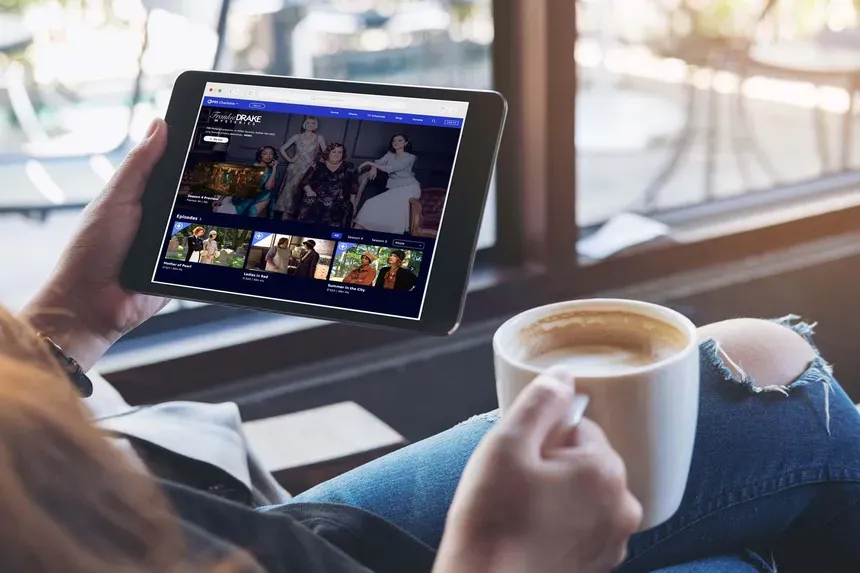
Introducing PBS Charlotte Passport
Now you can stream more of your favorite PBS shows including Masterpiece, NOVA, Nature, Great British Baking Show and many more — online and in the PBS Video app.Providing Support for PBS.org
Learn Moreabout PBS online sponsorship- (orchestral music) - This is a production of PBS Charlotte.
- Just add on a special episode of Carolina Impact.
We'll explore how innovation continues to shape our region.
- (Jeff) So can't get to the hospital.
Well, how about the hospital coming to you?
I'm Jeff Sonier.
Stick around, We'll show you how a new technology and old fashioned face-to-face care, can help turn your living room or bedroom into a hospital room.
- The sustainable coffee, truck and outdoor fire pits.
The Charlotte innovation barn is the city's newest hangout spot.
But inside this old city garage is an incubator for sustainable businesses, unlike any other in the country.
We're gonna to take you on a tour.
- And from activist to gamer, to non-profit founder, meet a man creating apps to transport people back in time.
- Sort of, Carolina Impact starts right now.
- Carolina Impact, covering the issues, people and places that impact you, this is Carolina impact.
- Good evening, thanks so much for joining us, I'm Amy Burkett.
From at home hospital visits to patients simulators for students to new apps and cool ways to recycle.
We're introducing you to advanced technology, creating new ways of doing things.
Charlotte's atrium health is giving us a first peak inside their innovative hospital at home program.
We'll meet the paramedics who are taking high level hospital health care on the road and the patients who never have to leave home to get the care they need.
Carolina impact's Jeff Sonier is at atrium health with a story you'll only see on PBS Charlotte.
- Yeah, during a health crisis like the pandemic.
It's ironic, that one of the hardest things to do was actually see a doctor, walk-in clinics were closed.
Treatments were canceled.
Even the hospital was over crowded, but over time, atrium health figured out a way to expand and enhance their hospital at home program.
Bringing more high level hospital type healthcare from their front door to your front door.
(dramatic drum playing) - Hi Sabrina.
Look at how good you look.
- He's atrium paramedic Chadwick Heagerty, visiting atrium patient, Sabrina Funderburk at home.
- So how you feeling?
- I'm feeling better.
- I see you're still on the oxygen.
- Yes - What are we flowing right now?
- We're at two Alright.
- Checking Sabrina's at home oxygen lab and her blood pressure, all right there on Sabrina's sofa.
- You have any pain today?
- No, headache - A little headache?
- Yes - Is it new?
- No (dramatic music) - Feel good, you feel like you're back to where you were?
all right, let's try it.
- Sabrina's part of atrium's hospital at home program, treating patients in their own living room instead of a hospital.
- You still feeling weak or is that coming back?
- Nope, so far so good.
- So far so good, okay.
We'll walk to the hallway and then back down.
- Here at home is where patients are more comfortable, where they can be with their families 24x7 instead of just visiting hours.
Edward Sabrina gets hospital care without leaving the house, personal care from her own personal paramedic.
- At least you're not stopping after every step.
(laughing) You're doing very good.
(orchestral music) - The ability to be at home with your loved ones and familiar surroundings but knowing that you have to care your need when you need it.
I think is the best of both worlds.
- Atrium's chief physician, Dr. Scott Rissmiller adds that the hospital at home program also frees up more in hospital beds, especially during COVID the patients who can't be treated at home.
And it's a lifesaver for patients who don't have a nearby hospital or can't get to a nearby hospital.
- To serve our underserved whether it be urban or rural, giving them access.
Going to them in their homes, in their communities.
No one at atrium health wants to go back to the old ways.
We now have these new tools that we can deploy and continue to build off.
- We're bringing in the hospital to them.
You know, there's things that we do today in their home that they would have had to have been in the hospital, to have done previously.
Which to me, I still can't wrap my head around it.
Like this is, why didn't we think it is years and years ago?
- For the hospital at home paramedics, like Heagerty, the day starts at this Atrium hospital.
Charlotte supply center turning his paramedic SUV into sort of a high-tech hospital room on wheels.
- You know, we all think about, you know, ultrasound machines is these big things that they roll around in the hospital.
- It Well - This we just technically hooked to an iPad and we can see the same thing that they do in the hospital.
We can do ultrasound IVs, things like that right in the patient's home so.
we can do 12 leads EKG in their home and we can actually transmit them to their file to the physician can view them.
Generally we can have up to four or five patients.
And with those patients, we see them at least twice, in most instances.
All right, I got to get my main supply box.
We can actually draw blood at the patient's house and we can drop it right in the lab at the hospital.
- (Jeff) Hospital at home medics also have the same meds, patients usually get in their hospital beds.
- It's our medication bag, we carry a massive amount of types of medications.
- (Jeff) Plus add home equipment that patients can use in some cases to take their own meds.
- They can put this in, they just press the thing and then they put this to their nose and take a big breath in their medication is administered.
Alright, so we're ready to go.
- We are really looking to take this one to quantum leap, in regards to the care we provide sort of that proactive 24x7 access in the home and deliver very high quality, high touched care, in the home.
- Hello there, how you doing?
- (Sabrina) I'm good, how are you?
- Good, you looking good.
- (Jeff) Hospital at home patients like Sabrina, also get house calls from their doctor while the paramedic is there.
- Do you feel very short of breath when you're up and moving around?
- A little, when I walk around - (Jeff) Face-to-face via mobile phone or tablet.
- How have you been doing with your sofa activities, have you been doing those pretty regularly?
- (Sabrina) Yes - (Jeff) With the paramedic taking notes for follow-up.
- So you know the contact number; you probably know about heart at this point, if you need anything give us a call.
- You have the medics that come and see twice a day.
You have the support of the same support you have in a hospital, but it's a little bit more personal to me.
They make you feel so good.
Even now like, if you're not having a bad day, they even encourage you.
You know that you're doing well.
- I feel pretty good about where she's at right now.
- With them alive but still have the support of the hospital there, they help you.
So you're never alone, you feel confident and you feel safe.
- (Jeff) Atrium's hospital at home program also has a 24x7 nurse hotline that patients can call anytime for a help or advice.
Sort of like that call button for the nurse that you have in your hospital room here at CMC.
And those high-tech monitors we saw during the story that let patients check their own blood pressure and oxygen levels and a heartbeat.
Well, they can also be monitored here at the hospital.
Amy?
- Thanks so much Jeff.
Atrium Health says as of October, they've treated about fifty-nine thousands patients through their hospital at home program.
That includes both acute care patients with paramedics like we just saw in that story.
And observation, only patients who communicate daily from home with atrium nurses at the hospital.
You can learn more on our website at pbscharlotte.org With the need for healthcare workers still in high demand.
A new simulation center is giving students hands-on experiences.
Central Piedmont opened its Leon Levine Health Science Center last year with some pretty amazing new technology.
But the center hadn't really been utilized because of COVID and remote learning until now.
Carolyn impact's Jason Terzis takes us inside the control room, that's helping launch careers.
- (Brenda) But you can see it starting here on the ribs and then it's rolling around to the back.
- It's the cutting edge of healthcare technology.
- (Brenda) But then we have middle trapezius and wheres it's line of Paul?
- Brenda Kannel teaches her occupational therapy students at Central Piedmont Community College by using the most advanced innovation.
- When our students get ready to go out to clinicals, we don't want them to walk into a hospital and then go oh this is what a hospital looks like, oh my goodness, there's too many machines.
I don't know what to do, that doesn't work.
- Brenda's class is taking place at the new Leon Levine Health Science Center.
It's a game changer for students.
- In so many ways.
- We were told that we were building a new building and we had an opportunity to build a SIM center.
- SIM stands for simulation and the entire fourth floor of the new building is filled with the latest in simulation technology, giving healthcare students a preview of real life experiences.
- The other thing that doesn't work, is only practicing on your classmates because your classmates are the most cooperative patients you ever done a gap.
- Nursing students own their skills in rooms, simulating an operating room, birthing center, mother and child simulation room and trauma rooms.
And each is equipped with tech dummies, which are more like robotic mannequins.
- They talk.
Yeah!
Yeah!
It's Ms. Scott doing the talking usually through the patient, so it's really cool.
- Here, we're given different scenarios that may not occur as a student while we're in the hospital.
And I just feel like we're given a lot of freedom to make mistakes or ask question.
- She is now in labor thirty-six weeks and she's had a small abruption.
- Instructors like Lisa Scott can teach in class or sit just outside the simulation rooms in glassed, in control rooms.
They can watch on monitors, record the sessions and over the intercom toss out various real life scenarios for students to deal with and hopefully learn from.
- Oh, I have a contraction.
- So this is our labor and delivery room and we have Victoria high fidelity mannequin who can actually birth the baby.
You can control the rate that she crowns.
You can control how much screaming you want the parent to have.
- So, with simulation it really helps, because, you know, we get to actually visualize the patient.
You know, they they're breathing the there, you know, you can see what's going on.
Their vital signs are up and I feel like I've learned how to assess a patient much more rather than just seeing the information like what's normal, what's abnormal.
You know,.
you're getting to see it in real life.
- With students taking turns in the simulation birthing room, the rest of the students are back in the classroom, watching on monitors and taking notes.
Afterward they all discuss the things they did well and what they can improve on.
- The worst part about it (laugh), is you're being filmed, it's like your classmates are watching you.
So I think, you know we're all going in there a little nervous.
- We're not out to get the student.
We want them to make their mistakes here.
The ability to reflect on them, their own performance and see really how they engaged with the patient.
How did they speak to it?
Did they make eye contact?
All of that is something that through watching yourself.
You learn and that's very different than somebody else telling you.
You did or didn't do something.
- Nursing students working towards their two year associates degree to become a registered nurse can expect some good paying jobs.
According to the US bureau of labor statistics.
The average registered nurse salary, in the United States is over seventy-seven thousand dollars.
However, in the Carolinas those numbers are slightly less.
With South Carolina ranking 40th among the states and pay with an average RN salary of about sixty-five thousand and North Carolina ranks thirty-seven with an average RN salary of more than sixty-six thousand.
The average for new grads entering the workforce in North Carolina is just under sixty-two thousand.
- We really believe we've done it, as good as anybody.
We had a consultant firm who specialized in healthcare help us design this fourth floor.
We designed it so that it allows us not only to meet our current needs but our future needs.
- The SIM center also has a pharmacy, clinical lab and check this out an actual apartment where students simulate physical therapy and what it's like to navigate an in-home type of setting.
The number one goal is to give students a better hands on experience and to create better prepared graduates for the workforce, which will ultimately better serve the healthcare needs of the community.
- So I think what we're going to see are more comfortable and confident students, who have a better understanding of everything because they've seen it inside and out.
- More prepared than I would be, if I didn't have this experience.
- Providing state-of-the-art education in the field, that's only expected to continue growing For Carolina Impact, I'm Jason Terzis reporting.
- I just always Marvel at what technology can do.
Thanks so much, Jason, for sharing that story with us.
The simulation center required an investment of more than 1 million dollar.
It was also designed to become an on-campus clinic.
So students could one day see patients there.
Every 17.3 seconds, north Carolinians throw away enough plastic bottles to reach the height of the bank of America building in Charlotte.
According to the state department of environmental quality.
In the queen city, only 11.5% of the materials that currently enter Charlotte's waste system each year are recycled or composted but the city is working to change that partnering with the nonprofit envision Charlotte to open a cutting edge incubator for sustainable businesses.
Unlike any other in the country.
Carolina impact's Rochelle Metzker takes us on a tour of the innovation barn.
(gentle rock music) - (Rochell) With a large outdoor space buyer pits and rocking chairs.
The innovation barn in Charlotte is a great place to sip a drink and enjoy skyline views.
Just be sure to bring your recyclables, because just inside this old city garage is a cutting edge incubator for sustainable businesses and zero waste initiative.
- We're the first of its kind in the country to have an innovation center focused on the circular economy.
- What is a circular economy?
Amy Aussieker, the executive director of envision Charlotte explains it like this.
- The linear economy is what we are now.
So we buy something, we use it and we throw it in the landfill, linear.
So a circular economy is like a forest.
So if a forest has a tree, it grows up, it dies, falls on the ground it rots, new nutrients grounds, there's zero waste.
So if you think about it, it's a zero waste society.
- Aussieker, shows us the plastics lab where takeout containers could be turned into filament.
- Filament can be used in 3D printers.
- They also have a glass pulverizer that turns wine bottles into sand.
- Just drop it in there.
So you have the little tiny, fine sand, a little bit bigger.
- Around the corner is a sustainable furniture shop that reduces waste by repurposing local Carolina trees that.
- We count the rings.
We know how old it is.
We know where it grew.
- Carolina, urban lumber makes dining and coffee tables, floating shelves and mantels at a workshop in pine bowl and sells them here.
- We knew the tree didn't get cut down for us making furniture.
- Founder Damon Barron says, a vast amount of woodways to send to landfills, on a daily basis.
He knew they were better uses for old natural resources, and so Carolina, urban lumber was born.
- Like, this is a prime example.
This does not get into the bulk lumber industry where we get two by fours or flooring.
This is so disfigured and ugly as a log that it gets trashed.
But to me, this is, this is prime material.
- Barron says he's proud to be a part of innovation barn, where people are striving for common goals.
- So these plants are the different varieties of lettuce.
- Charles Oliphant shows us the produce, being grown, using a system called aquaponics, a method of farming that raises edible freshwater fish to Lafayette, in this case and vegetables together in a symbiotic environment.
- Aquaponics is the process where by the fish produce waste and it's converted by bacteria to nitrogen fertilizer for the plants.
The plants then clean the water which goes back to the fish.
- Oliphant is with hundred gardens, an organization that builds aquaponic programs in schools, institutions, and communities of need, teaching people how to grow food while conserving water.
- So all aquatics uses approximately a 10th of the water.
- The system will produce about 300 heads of lettuce a week which will go to restaurants and food banks in the region.
- You don't have to understand the whole thing about how it works to make the work.
And that's why it's great for education.
- Educating people and changing the way they think about their food is the mission of 100 gardens.
Then the learn how to prepare it in the teaching kitchen across the hall.
The kitchen features four stations with double induction ranges, donated by Electrolux.
Residents can sign up for cooking classes on how to limit food waste in canned vegetables.
Folks in Charlotte loved their beverages.
That's where Repour bar comes in.
Folks will be able to come, in sip on a craft beer or glass of wine and learn how they can make the city or sustainable.
(guitar playing) The circular economy continues with mush and urban mushroom farm that harnesses the power of fungi to reduce wastes.
- So the mushroom actually grows underground and is actually what you can see on the whites, in the bags behind me.
And really what that does is that's breaking down wood and waste that we have in our environment.
- Mushes, Josh Partridge was brought in to run the innovation Barn's mushroom operations.
Currently he's repurposing wood shavings from Carolina urban lumber to produce gourmet and medicinal mushrooms for purchase.
- Our plan for mushrooms is to grow two times of mushrooms to start off, they are Oysters mushrooms and Lions mane.
- Just steps away is a composting lab that employees, soldier flies to decompose food waste.
- So they were all in here eating.
These are a bunch of edamame and peels and potato skin, - A local food waste diversion group runs the lab.
- This is all a household stuff, we just started this spend last week.
We've got about a five-thousand black soldier fly larvae in here.
- David Valdor with crown town compost says black soldier flies are important for Charlotte circular economy.
- They're really good at converting food waste into protein.
That's good for animal feed.
So we're keeping that in the loop, instead of putting it go to the landfill.
- Eventually the black soldier flies will be harvested and fed to the fish at 100 gardens.
Through this process, Founder says nothing goes to waste.
- It's about two hundred thousand tons of food waste per year in the Mecklenburg county alone.
Food waste in a landfill is breaks down with no oxygen and that results in methane production, which is a greenhouse gas.
- In eliminating greenhouse gases is the ultimate goal.
- Reducing climate change fundamentally full-stop.
That's all we have to do - A monumental task that begins one bottle at a time where Carolina impact I'm Rochelle Metzker.
- Thanks so much for shell future plans for the innovation barn include programming partnerships with local universities and corporate partnerships for product development and education.
They also hope to launch a monthly speaker series and offer classes to teach people about things like vertical farming and home repairs.
Well, a Charlotte activist has found a way to merge his passion with technology to create unique apps.
Now, those apps are helping organizations like the Levine Museum of the new south and solid waste management connect with users to entertain and educate Carolina impacts Sarah Cologne.
Harris introduces us to this innovative mastermind.
- The signs that you see here, we worked with the Levine museum of the new south and the Charlotte department of transportation to get these installed.
- When it comes to the latest app, he designed Michael Zhukov can't stop talking.
- Actually download the app.
And the app is called Know CLT.
- Know CLT.
As in K N O W CLT.
The massive project commissioned by the Levine museum of the new south connects players to Charlotte's historic Brooklyn neighborhood using augmented reality.
- We run into this, you know, location.
You say, Hey, I'm going to start here and I'm going to go to as many sites as I want it.
You can freely do it as you, as you please, but you'll notice there's also footprints installed on the ground.
It works.
- Like this.
Download the app, stand on the footsteps at any of the seven sites in uptown.
Charlotte, want your cell phone at a target and rolla.
- Right know that image faded over it.
- You've been transported in time through photos and oral histories.
- And this one's really incredible because you can see the pre-existing buildings here and you can see there is JT Williams home.
- J T Williams, a prominent teacher, physician and diplomat once lived in Charlotte's black community, known as Brooklyn in the early 19 hundreds.
The community of about seven-thousand people forced out by the city in the sixties.
After nearly fifteen-hundred homes were deemed blighted.
- You know, the fabric of a community was basically severed through this process of urban renewal.
- The app is part of the Levine Musem's new digital effort to merge technology with history.
- Well, we want to meet people where they are, right?
And everybody's on their phone.
Everybody's online.
And we want history to be more accessible.
- Well that people at the museum and the new south has done an amazing job is collecting so much different information to show the full diverse experience of life that was here.
The cultural experiences, the political experiences, that economic experience that this truly was the heart of black Charlotte.
(orchestral music) - As a former history teacher activist and avid gamer bringing the app to life through his non-profit potions and pixels is a dream come true for Michael.
- Oh, mission is to utilize games, to create social impact.
And so with the games that we've created, the events we've hosted the workforce development projects, the camps for the youth, that's our way of using interactivity art technology and gaming to better our community.
- Sounds fun, but the journey required a test of courage after leaving his full-time job in late 2019, Michael stumbled into 2020 as a social entrepreneur.
It didn't take long though for the word to get out.
- 2020 Was an interesting year to pursue something full time.
We had a number of hurdles to get through but I'm super excited about what we are right now.
- He says the Know CLT app took about three months to produce requiring a team of designers, developers, and artists.
- The app is based on utilizing GPS.
So, which is wild of think that our app here is utilizing satellites and in the space but GPS, Gyroscopes, and Accelerometers.
We have a custom server that we created.
- The complexity of the projects has attracted the interest of other organizations looking to connect with their audience through technology, potions and pixels recently partnered with Charlotte solid waste services to create the Trash Dash app.
- I wanted to do something that actually put our consumers in the role of actually having to run the operation.
- Using a Raccoon as the main character, the app allows users to learn more about their trash pickup services, creating more awareness and even a little empathy for the job.
- I call this bridging the empathy gap.
Helping people better understand the roles and the work that other people in our community do.
- I think they get a chance to do it, and then they get addicted and they want to get a better score.
And so I think it continues to keep them thinking and strategizing about what they can do to help improve and what we do.
And so the facts that we include in there, I think helped give them an idea of what they can do to help support for better running operation.
- And there's Perks.
Fifteen of them by customizing the operation users can unlock faster trucks and recycling programs.
- That's been really fun, just seeing different players in the community, often times run into people and they'll whisper to me one of the best parks.
I want to know what the perks I should have.
- Michael.
It's all more than he ever hoped for his life pursuit of developing games.
Finally, coming into focus for Carolina impact I'm Sarah Cologne, Harris reporting.
- Just another example of a super cool app.
Well, thanks Sarah for sharing that with us.
That's all we have time for this evening.
We hope you enjoyed this innovation special.
Thanks so much for joining us.
We always appreciate your time and look forward to seeing you back here again.
Next time on Carolina impact.
Good night, my friends.
(dramatic orchestral music) - A production of PBS, Charlotte.
Carolina Impact: October 26, 2021 Preview
Preview: S9 Ep7 | 30s | Carolina Impact: October 26, 2021 Preview (30s)
Video has Closed Captions
Clip: S9 Ep7 | 4m 42s | Healthcare students get hands on experience with Central Piedmont's new simulation center (4m 42s)
Video has Closed Captions
Clip: S9 Ep7 | 6m 21s | Atrium health has launched a new hospital at home program (6m 21s)
Video has Closed Captions
Clip: S9 Ep7 | 5m 30s | A new cutting edge incubator opens to turn recyclables into treasure (5m 30s)
Video has Closed Captions
Clip: S9 Ep7 | 4m 46s | A non-profit app developer creates an app to transport people back into history (4m 46s)
Providing Support for PBS.org
Learn Moreabout PBS online sponsorshipSupport for PBS provided by:
Carolina Impact is a local public television program presented by PBS Charlotte

